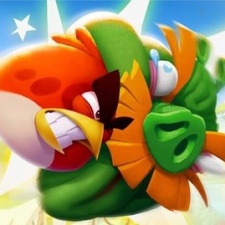Michail Katkoff is Studio Lead at FunPlus.
This article was originally published on Deconstructor of Fun.
When Angry Birds 2 was launched at the end of July in 2015 it received mixed reviews. Both Pocket Gamer and IGN applauded the game for gorgeous graphics and vastly improved level design while faulting Rovio for employing the Candy Crush-like lives mechanic and randomised levels.
"Ever-shifting levels and limited lives take a lot of the fun out of smashing pigs with birds in Angry Birds 2."
- Review of Angry Birds 2 on IGN
Looking at the downloads, the launch of Angry Birds 2 was a massive success. By the end of 2015 the game had racked up close to 50 million downloads. On the revenue side, things nevertheless looked much gloomier as the game had generated roughly “only” $10 million.
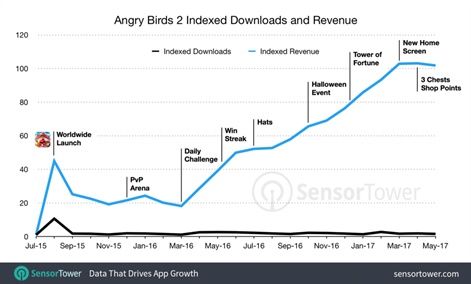
Instead of keeping up the course of just adding more levels, the Stockholm studio behind Angry Birds 2 went to work. The updates in 2016 introduced several core mechanics such as leveling up of Birds and the Slingshot, Daily Challenges and Player vs Player Arena while at the same time keeping the rigorous level content cadence up and running.
With each update, the game’s revenue peaked to new heights without declining to the previous lows. Today Angry Birds 2 is a perennial top 50 grossing game, and it’s only because of the top-notch updates which have successfully introduced midcore elements to a super casual game.
The history, and my experience, of Angry Birds’ monetisation
A long, and in mobile game years very long, time ago my powerful team of five and I took on a challenge. We wanted to show that we could convert Angry Birds from a classic paid game into a free-to-play game. We argued that by doing so, we would not only increase the game’s revenue but also increase engagement and retention.
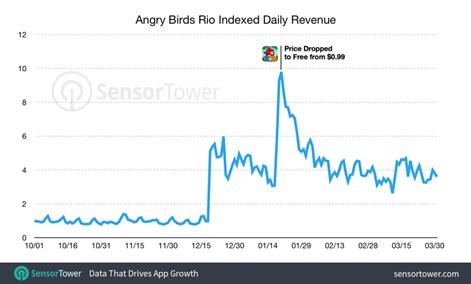
Back in 2012 going free-to-play was considered a revolutionary endeavour at Rovio. The paid games, such as Angry Birds Space and Angry Birds Star Wars did close to dozen(s) of millions of dollars on their launch weeks alone and the only free-to-play game, Angry Birds Friends, was delivering hefty weekly revenues despite significantly underperforming when looking at KPIs such as the revenue per daily active player.
To sum it up, in 2012 everything was better than great and no one wanted to break the formula.
“One dollar for a game is enough. We don’t want to be Zynga.”
- former SVP of Games of Rovio
Half way through 2012 new games emerged. First NaturalMotion’s CSR Racing (read CSR's deconstruction here) broke all the grossing records. Then Supercell, located only a few miles away from Rovio HQ, launched Clash of Clans (Clash of Clans deconstruction here) and Hay Day (and Hay Day's deconstruction here) which both parked permanently on the top of the grossing charts for fuve years (!!!).
The combination of new top grossing free-to-play hits and the worse than expected performance of Bad Piggies and Angry Birds Space 2 opened the minds of the leadership to enable my team to experiment with free-to-play mechanics.
Not to mention the fact, that there was half-a-dozen of Angry Birds SKUs with a small team on each creating about 30 levels every month basically at a loss since the games they were adding the levels to had no monetisation other than the one dollar price, which players had paid years ago.
Due to all the facts above, my game team of six was given the ok to experiment with Angry Birds Rio and make our case that we could improve retention, engagement, and monetisation without hurting the ratings/fans. Our approach to achieving these goals was simple. It had to be because there’s only so much you can do with such limited resources.

Firstly, we increased the replayability of each level. We knew that players primarily wanted more levels to play but that was also the bottleneck of production. It took a day to create a level and about two minutes for a player to beat it.
The solution was to introduce mastery. By earning Stars, players would unlock specific Star-gated levels. For each episode of 30 levels, we added only three additional Star Levels which player would unlock after their collected 30, 60 and 90 stars. In other words, we incentivised the player to replay levels until they three-starred all levels.

Secondly, we added a monetisation mechanic. After introducing the mastery and encouraging players to three-star all the levels, we introduced four different boosters. Create demand than offering a solution. We weren’t allowed to use lives-mechanic. It was considered as a too punishing of a game mechanic. Rovio was, and still is, a fan driven company that will put the interest of their customers ahead of the short-term business interest.
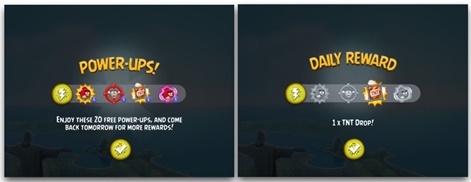
Thirdly, we added a daily bonus to drive retention and to get players experimenting on boosters. The daily bonus was a simple roulette that rewarded the player with one of the four different boosters.
This simple update, combined with turning the game from paid to free resulted in Angry Birds charging to the top of downloads charts and subsequently climbing into top 100 grossing up from an unranked position. Increased installs led to increased player base and that again let to multiplied ad revenues. The update was a success and these simple yet effective solutions were adopted across all the Angry Birds games on mobile.
What’s so new about Angry Birds 2?
There were several skeptical looks cast on the title of the game, Angry Birds 2. And that’s understandable because when you play the game for the first time, it does feel like a classic Angry Birds game. I mean, you have a slingshot, you have the different birds and you have the pigs. What’s so new about this game?
Well, those of you who stuck longer than first 20 level, know that this game is truly worthy of its “2”.
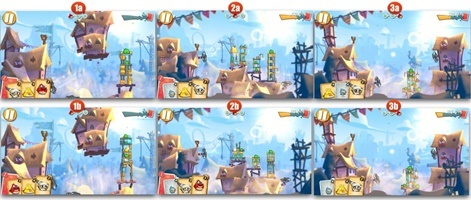
Firstly, and obviously, the graphics and the overall UX is much improved. For example, when you put a bird on the slingshot and stretch it, a zoomed in image of the bird in the slingshot appears. And when you aim at the pig, and image of the pig in shaking in stress will appear. Oh, and the fast-forward mechanic, which is something all the Angry Birds should have.
Secondly, the levels in Angry Birds 2 are multi-staged. Instead of destroying of pig structure per level, player destroys several structures in a row. This is a great design change combined with the Bird Cards design, where a player doesn’t see all the birds she has for the level but instead draws new ones as the level progresses.
Dynamically tuned levels – and the expertise of tuning them based on player behaviour – is King’s core competence and ‘secret sauce’.
This design makes the levels more exciting as you don’t know what structure comes next or what birds will you have to tackle the challenge. Choosing which bird to use and which to save makes the levels, in my opinion, more fun.
Thirdly, the levels are randomised to an extent. What I mean is, as you restart the level, the structures will be different than it was during previous try. This is a major improvement that allows dynamic tuning of the levels. Theoretically, if a player is progressing too fast through the levels, the structures should get more challenging causing a player to replay the levels or pay for boosters and extra birds.
Dynamically tuned levels – and the expertise of tuning them based on player behaviour – is King’s core competence and ‘secret sauce’.
Fourthly, Angry Birds 2 features multiple progress paths, which in order create several currencies and sinks.
There’s the player’s account level, which grows as the player collects stars by completing levels. The account level is used to gate features such as the Daily Quests, Daily Challenge, and the Arena mode. Account level incentivised the player to replay levels till they are three-starred.

Then there are the birds, which player can level up by collecting different coloured Feathers found in the Chests. Leveling up birds increases the destruction points they generate upon collision.
Points not only allow to get that coveted three-star-rating but they also contribute to getting the additional bird to sling. There’s the power bar on each level that gets filled based on a number of destruction points player causes. When the bar fills up, the player receives another bird card. Genius!

In Angry Birds 2, the player can level up the slingshot itself. To level up the slingshot player first needs to unlock all the birds, which requires beating first 44 levels. Then player needs to purchase hats for each of the birds. Hats are purchased with Black Pearls, which are found in gacha chests.
There are several different hats for each bird making the collection highly repeatable and thus increasing the overall demand for Black Pearls.

Finally, there are the social features. By collecting the game to your Facebook account you will see all of your playing friends on the King-style level map and on the level-specific leaderboards. There are also friend gifts, which player can collect from levels and send to their friends. Player can’t gift lives though, which is against the benchmarks.
When you look at the laundry list of all the new features and compare it to the classic Angry Birds games, you can only agree the game more than deserves its “2”. The game looks better, plays better and offers a wide variety of totally new features and game modes. But most importantly, Angry Birds 2 monetises like a best-in-class puzzle game.
#1 Monetisation mechanic – Premium currency
Angry Birds uses hard currency in form of Gems instead of relying on direct purchases. As most of you know, hard currency beats direct purchases due to four key reasons:
Most importantly, Angry Birds 2 monetises like a best-in-class puzzle game.
1. Hard currency increases retention. When players are incentivised to purchase more hard currency than they need it creates a money-in-the-bank situation. Players are incentivised to come back to the game because they have hard currency, which they paid for.
2. Hard currency increases the size of an average purchase. Just increase the smallest price point and implement volume discounts and voilà, you’ve increased the average revenue per paying user.
3. Hard currency enables effective use of incentivised video ads. As soon as a game establishes demand for hard currency, drip of hard currency can be employed to incentivise players to complete various actions. Tournaments, missions, daily bonuses, challenges, events, you name it. Giving players the opportunity to earn something worth real money increase retention and sometimes encourage conversion via trial.
4. Hard currency allows the player to take the most out of the game when off-line. Say you’re on a plane. You probably have time to play few more games than what the 5 lives give you. Well, then before you take off make sure to fill up on that hard currency and buy more lives while off-line.
Angry Birds 2 establishes several strong sinks for Gems to drive the demand. This demand is ultimately met in the Gem shop, which in Angry Birds 2 is above the competition. The Gem Shop features 9 different Gem packages player can purchase ranging from 0.99 cents to 99 dollars.
Normally a shop puts all the offers in line from cheapest to the most expensive and prices them in a way that player is incentivised to choose either the biggest or the second biggest one. Angry Birds 2 does this and more.

Firstly, with every purchase player earns Stamps, which are VIP points that grant the player bonus on their purchase. This drives the player to not only choose a bigger package of Gems but to also do repeat purchases to increase their VIP status. Secondly, the game offers subscription purchase where a player is given Gems every day for a month. This is a good package to drive retention for converted players.
#2 Monetisation mechanic – The lives
Angry Birds 2 features the classic lives mechanic. Every time player fails a level, they lose a life. The player has five lives. Once they lose all the lives they can either wait as each life takes 30 minutes to refill or they can pay to refill the lives instantly.
A lives mechanic is not only a good monetisation mechanic that monetises on player’s binge sessions, but it’s also a solid retention mechanic – a player is compelled to come back to the game when the lives are refilled.
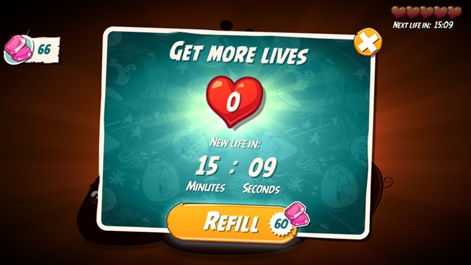
Personally, I believe Angry Birds 2 could improve the efficiency of this mechanic by increasing the difficulty of the levels. I may be a pretty good Angry Birds player but after 50 levels I have experienced close to zero challenge. By increasing the amount player fails per level you will decrease the speed player goes through the content, increase engagement as players will play several times a day and monetise through life refills.
Just to be clear, I'm not suggesting an increase in overall difficulty. Rather making some of the blockers "Boss levels" even harder as they are now for a player cohort that is beating the game at a significantly higher pace than average. I'm fully aware that lack of difficulty in early game results in higher mid-term retention.
Overall though, lives don't traditionally drive monetisation in puzzle games. It's more of a retention mechanic that limits the session length and creates a timed incentive for players to return back to the game. Also, difficulty in early levels can be low since it locks players in.
They need a few "blocking" levels which show this game is difficult, but I've seen enough AB tests of difficulty to know that starting off easy = better retention past 14D.
#3 Monetisation mechanic – Extra Move
The Extra Move mechanic is a parachute for players who are about to fail a level. This feature typically drives the majority of saga-based monetisation. Making levels which create a lot of near misses drives the monetisation of the extra move.
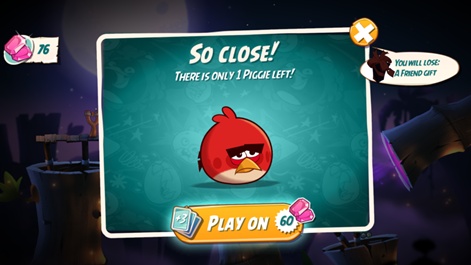
Imagine you have been going at a level for several sessions. You are about to beat and sling your last bird at a King Pig just to witness that you almost took the King Pig down. At this point, the game offers to give you few more birds to continue the level and, very likely, beat it.
Again, this is a mechanic that could produce a far better result if the game would make a good use of its dynamic tuning feature. By segmenting players based on the speed of their progress and completion rate, you can give much more difficult levels to the most engaged players. These engaged players would fail more often and thus utilise not only the life refills but also the Play On! to beat these tough levels.
#4 Monetisation mechanic – the Chests and ads
As described previously, Angry Birds 2 has several progress trees that all take different currencies. The way to earn these currencies is through the Chests. Player receives a free chest every 30 minutes.
Each chest has five cards, which are shown to a player upside down when a player opens the chest. Player then chooses one of the cards that is turned along the other cards. The player can purchase more valuable chests with Gems or watch ads to open more Common Chests.

The design of this feature is waterproof yet I don’t really believe that it monetises as well as it could. Firstly, a player is given a free chest every 30 minutes, which is a bit of an overkill.
Secondly, the content of the Chests is fun but not really needed. Leveling up birds and the slingshot is not that useful unless player engages in the Arena mode.
By increasing the difficulty of the levels and tuning down the Destruction Points players would crave the Feathers and the Black Pearls, which are found in chests and needed to level up the slingshot and the birds.
#5 Monetisation mechanic – The Arena
Every three hours, the player receives a Ticket, which allows them to enter the Arena. In the Arena, a player goes head to head against other players in an asynchronous battle of Angry Birds. The player who racks up more destruction points wins the battle.
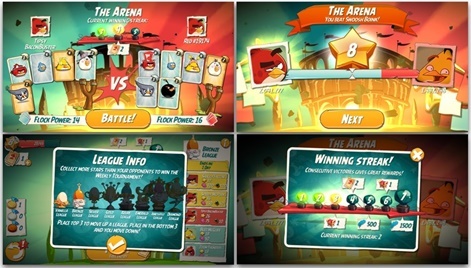
The core gameplay of the Arena feature is pretty much what Angry Birds Friends did back in 2012 was. The difference is that the Arena feature is only one element of Angry Birds and it’s just significantly better designed and executed.
Firstly, the Tickets that player needs to play the Arena significantly limit the number of times player can play the Arena mode. This makes each match much more meaningful. Losing a match forces player to wait three hours before they can play the Arena again.
Secondly, the Winning Streak design pushes the player to play, and win, more Arena battles by rewarding the player for consecutive victories.
Thirdly, the League element gives a strong sense of progress and competition. The leagues in Angry Birds 2 is designed in a traditional and safe way. The player is put in the same bracket with 15 other players for a week. Each asynchronous battle rewards players with up to 10 Stars, depending on how badly they beat their opponent in destruction points.
The Arena is the most powerful feature of Angry Birds 2 both in terms of increasing engagement and monetisation.
Three players who earn the most Stars in during a week will move up a League tier when the time ends while the three players with the least number of Stars will be relegated to the previous League tier. There are eight League tiers and due to the time-lock, it will take over seven week at minimum to reach the highest tier. Simple, straightforward and it works!
Tickets, Winning Streak and League drive the engagement and the prestige, which in turn increases monetisation via up to five different ways:
1. Players monetise by purchasing Tickets, which are like the lives of Arena mode. Because of the timed nature of the Leagues, the player is incentivised to purchase tickets to win Stars and avoid relegation or push for promotion.
2. Players monetise by purchasing more birds when they run out in a battle. The Extra Move mechanic allows the player to purchase three more random birds to continue racking up destruction points.
3. Players can use all their boosters to rack up more destruction points and beat their opponents. Boosters can be purchased through gacha boxes, not directly like in other Angry Birds games. This makes them more valuable.
4. Finally, by leveling up birds and the slingshot player will rack up more destruction points. This way the Arena mode ties back to the core progression mechanics as the player is incentivised to earn or purchase more gacha boxes earning different Feathers and Black Pearls.
In my opinion, the Arena is the most powerful feature of Angry Birds 2 both in terms of increasing engagement and monetisation. It’s engaging, offers progression and monetises by driving players to compete. The Arena is also straight up pay-to-win as players can ensure their win by purchasing more birds and using boosters. But you know what, it doesn’t matter to the super casual players of Angry Birds.
#6 Monetisation mechanic – The Spells
The Spells are same as the boosters we added into Angry Birds Rio. The player can use Spells on all level except the more difficult boss levels. There are five different Spells that range from a laser gun to exploding chilies. Using Spells is quite boring since they are automatic and don’t require any skill. While the Spells look different, there seems to be little functional difference between different Spells.
The most important use of spells is in the Arena, where they allow the player to win much easier. It creates a bit of a pay-to-win scenario, but I don’t think that the players of Angry Birds care about fair-game or balancing.
#7 Monetisation mechanic – the Tower of Fortune
The Tower of Fortune is a daily bonus feature with a gambling mechanic twist. Here’s how it works: Player access the Tower of Fortune once every day. The visual representation of the feature is an elevator which stops at every floor.
At every stop, player is presented with four cards. Three of the cards are rewards that get better every floor while one of the cards is a pig that will take all the rewards that you’ve collected till that point. And to keep the player moving forward, every fifth floor is a risk-free jackpot floor with no pigs hiding in the cards.
In other words, it’s a game of double-or-nothing. If a player chooses to flip a card they have a 75% chance to increase the reward they will receive and a 25% chance to lose it all. Before flipping a card, the player has a chance to walk away and take all the rewards they received till that point.

So how does the Tower of Fortune monetise? Well, it’s simple. When player eventually flips a card and encounters a pig she will have an option to either forfeit all the rewards that have been collected till that floor or to pay gems to continue.
With every pig, card player flips the price to continue will increase significantly. As players move through the levels the reward they accumulate increases and a player is willing to pay the steep sum to continue rather than losing all the rewards they gathered.
Angry Birds 2 is a best in class example of a casual game that has successfully adopted traditional midcore mechanics.
It's a casual game with midcore mechanics
Casual games are accessible. They tend to boast large amounts of daily active users while subsequently suffer from low revenue per player. Then there are so called mid-core games, which are less accessible yet much better at monetising their players.
As the user acquisition costs have risen and the mobile games market gotten extremely saturated, games with low monetisation and thus low player life-time values (LTV) have started to incorporate midcore mechanics into their games.
Angry Birds 2 is a best in class example of a casual game that has successfully adopted traditional midcore mechanics. When the game launched, it was pretty much an improved version of good old Angry Birds.
Yet when the initial installs ran dry the reality hit the game team - the LTV was far too low to for effective user acquisition and without a steady stream of downloads the game was destined to wither away.
The Stockholm team behind Angry Birds 2 went to work delivering a steady stream of features, which methodically propelled the game from steady decline to one of the top 50 grossing games. That, ladies and gentlemen, is how you run live operations and redefine new standards for a genre.

